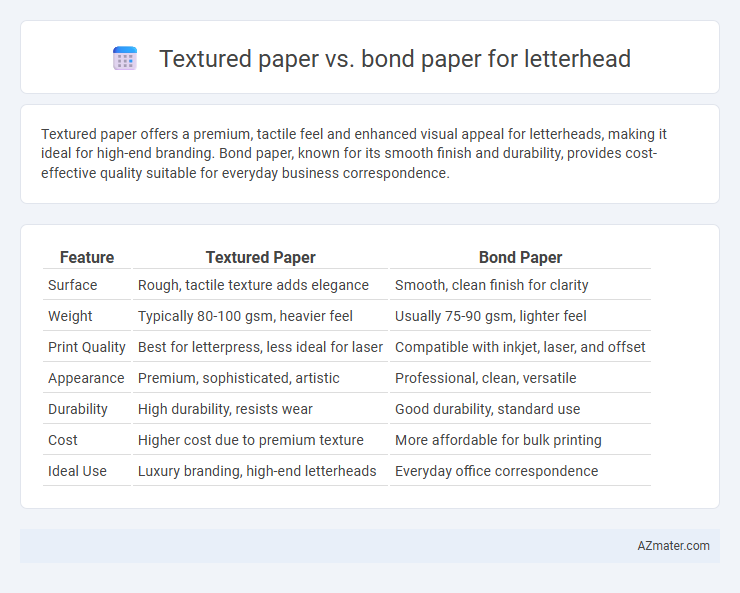Textured paper offers a premium, tactile feel and enhanced visual appeal for letterheads, making it ideal for high-end branding. Bond paper, known for its smooth finish and durability, provides cost-effective quality suitable for everyday business correspondence.
Table of Comparison
| Feature | Textured Paper | Bond Paper |
|---|---|---|
| Surface | Rough, tactile texture adds elegance | Smooth, clean finish for clarity |
| Weight | Typically 80-100 gsm, heavier feel | Usually 75-90 gsm, lighter feel |
| Print Quality | Best for letterpress, less ideal for laser | Compatible with inkjet, laser, and offset |
| Appearance | Premium, sophisticated, artistic | Professional, clean, versatile |
| Durability | High durability, resists wear | Good durability, standard use |
| Cost | Higher cost due to premium texture | More affordable for bulk printing |
| Ideal Use | Luxury branding, high-end letterheads | Everyday office correspondence |
Introduction: Choosing the Right Paper for Letterheads
Textured paper offers a tactile, premium feel that enhances brand perception for letterheads, making it ideal for businesses seeking to convey sophistication and uniqueness. Bond paper provides a crisp, smooth surface with excellent print clarity, favored for its durability and cost-effectiveness in high-volume letterhead production. Selecting between textured and bond paper depends on balancing aesthetic appeal with budget considerations to ensure the letterhead aligns with brand identity and functional needs.
Overview of Textured Paper and Bond Paper
Textured paper features a raised or embossed surface that adds tactile dimension and visual interest, enhancing the professional appearance of letterheads with a unique, sophisticated feel. Bond paper is smooth, durable, and typically lighter weight, offering a clean and traditional look that ensures high-quality printing and sharp text clarity. Both papers are acid-free options commonly used for official documents, with textured paper providing a premium aesthetic and bond paper delivering functional reliability.
Appearance and Aesthetic Differences
Textured paper offers a tactile surface with visible patterns like linen or laid finishes, giving letterheads a more sophisticated, artisanal appearance that enhances brand prestige. Bond paper features a smooth, clean surface that provides a crisp, professional look ideal for formal correspondence and high-quality printing. The choice between textured and bond paper significantly impacts the letterhead's visual appeal, with textured paper conveying elegance and bond paper delivering clarity and simplicity.
Texture and Tactile Experience
Textured paper offers a distinct tactile experience with its embossed or linen-like surface, enhancing the perceived quality and professionalism of letterhead materials. Bond paper, typically smooth and lightweight, provides a clean and crisp feel but lacks the intricate texture that adds depth to printed designs. Choosing textured paper elevates the sensory engagement of recipients, making business communications feel more premium and memorable.
Print Quality on Textured vs Bond Paper
Textured paper offers a sophisticated finish that enhances ink absorption, resulting in sharper and more vibrant print quality for letterheads, making logos and text appear more distinguished. Bond paper provides a smoother surface that ensures clean, crisp prints, ideal for professional documents requiring high clarity and legibility. Choosing between textured and bond paper depends on the desired visual impact, with textured paper emphasizing elegance and bond paper prioritizing straightforward readability.
Durability and Longevity
Textured paper offers enhanced durability with its thicker fibers and embossed surface, making it resistant to wear and tear for prolonged use in letterheads. Bond paper, typically smoother and lighter, provides moderate longevity but is more prone to creasing and yellowing over time. For letterheads requiring a lasting impression, textured paper ensures superior longevity and resilience against frequent handling and environmental factors.
Professionalism and Brand Perception
Textured paper enhances letterhead professionalism by adding tactile depth that conveys sophistication and attention to detail, elevating brand perception and trustworthiness. Bond paper offers a smooth, clean finish that suggests efficiency and clarity, aligning well with brands emphasizing straightforward communication. Choosing between textured and bond paper impacts how clients perceive a brand's identity and values through subtle but powerful sensory cues.
Cost Comparison
Textured paper generally costs more than bond paper due to its unique surface patterns and higher quality materials, which enhance the letterhead's visual appeal and tactile experience. Bond paper remains the more budget-friendly option, offering durability and smoothness suitable for everyday business correspondence without significantly increasing printing expenses. For companies prioritizing cost-efficiency, bond paper provides a practical solution, while textured paper suits premium branding despite its higher price point.
Suitability for Different Letterhead Purposes
Textured paper offers a sophisticated, tactile feel ideal for formal letterheads, enhancing brand prestige in luxury, legal, or creative industries. Bond paper provides a smooth, professional surface suitable for everyday business correspondence, ensuring clear print quality and cost-efficiency. Selecting textured paper supports premium presentation needs, while bond paper excels in functional, high-volume letterhead applications.
Conclusion: Which Paper is Best for Your Letterhead?
Textured paper offers a sophisticated, tactile feel that enhances brand perception and adds a premium look to letterheads, making it ideal for businesses seeking elegance and uniqueness. Bond paper, being smooth, durable, and cost-effective, suits high-volume printing needs and ensures crisp text clarity for professional communication. Choosing between textured and bond paper depends on balancing budget constraints with the desired impression, where textured paper is best for distinctiveness, and bond paper excels in practicality and economy.

Infographic: Textured paper vs Bond paper for Letterhead
 azmater.com
azmater.com